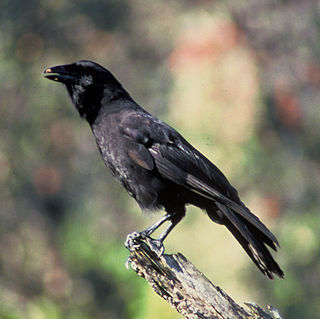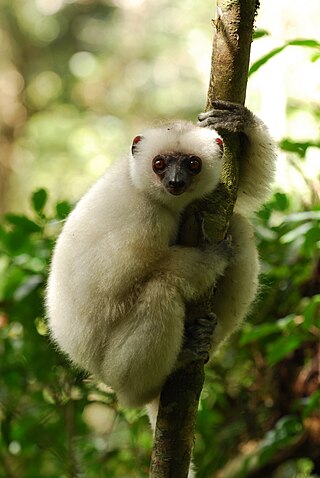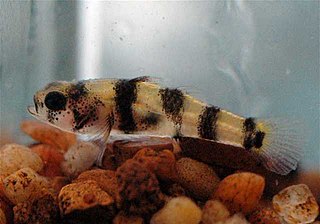
Mackerel is a common name applied to a number of different species of pelagic fish, mostly from the family Scombridae. They are found in both temperate and tropical seas, mostly living along the coast or offshore in the oceanic environment.

Herring are various species of forage fish, mostly belonging to the family of Clupeidae.

The International Union for Conservation of Nature (IUCN) Red List of Threatened Species, also known as the IUCN Red List or Red Data Book, founded in 1964, is an inventory of the global conservation status and extinction risk of biological species. A series of Regional Red Lists, which assess the risk of extinction to species within a political management unit, are also produced by countries and organizations.

The bumblebee fish is a species of fresh and brackish water goby native to Thailand and Indonesia. This species can reach a length of 3.8 centimetres (1.5 in) SL and is found in lower parts of rivers, coastal areas, mangroves and highly vegetated areas.

Brachygobius is a small genus of gobies. They are popular aquarium fish where a number of species are sold as bumblebee gobies because their colours are similar to those of bumblebees.

A species that is extinct in the wild (EW) is one that has been categorized by the International Union for Conservation of Nature as only consisting of living members kept in captivity or as a naturalized population outside its historic range. Classification requires exhaustive surveys conducted within the species' known habitat with consideration given to seasonality, time of day, and life cycle. Once a species is classified as EW, the only way for it to be downgraded is through reintroduction.

The large woodshrike is found in south-eastern Asia, Sumatra, Java, and Borneo. Its natural habitats are temperate forest, subtropical or tropical moist lowland forest, subtropical or tropical mangrove forest, and subtropical or tropical moist montane forest.

A vulnerable species is a species which has been categorized by the International Union for Conservation of Nature as being threatened with extinction unless the circumstances that are threatening its survival and reproduction improve.

The World's 25 Most Endangered Primates is a list of highly endangered primate species selected and published by the International Union for Conservation of Nature (IUCN) Species Survival Commission (SSC) Primate Specialist Group (PSG), the International Primatological Society (IPS), Global Wildlife Conservation (GWC), and Bristol Zoological Society (BZS). The IUCN/SSC PSG worked with Conservation International (CI) to start the list in 2000, but in 2002, during the 19th Congress of the International Primatological Society, primatologists reviewed and debated the list, resulting in the 2002–2004 revision and the endorsement of the IPS. The publication was a joint project between the three conservation organizations until the 2012–2014 list when BZS was added as a publisher. The 2018–2020 list was the first time Conservation International was not among the publishers, replaced instead by GWC. The list has been revised every two years following the biannual Congress of the IPS. Starting with the 2004–2006 report, the title changed to "Primates in Peril: The World's 25 Most Endangered Primates". That same year, the list began to provide information about each species, including their conservation status and the threats they face in the wild. The species text is written in collaboration with experts from the field, with 60 people contributing to the 2006–2008 report and 85 people contributing to the 2008–2010 report. The 2004–2006 and 2006–2008 reports were published in the IUCN/SSC PSG journal Primate Conservation,, since then they have been published as independent publications.

Oryzias mekongensis is a species of fish in the family Adrianichthyidae. It is endemic to the Mekong River Basin in southeast Asia, where it is found in ditches, canals and ponds.

Brachygobius doriae, the bumblebee goby, is a species of goby native to fresh and brackish waters of Indonesia, Brunei and Singapore, Malaysia, Cambodia, Thailand and Vietnam. This species can reach a length of 4.2 centimetres (1.7 in) TL. It is listed as Least Concern as no threats are known and it is popular in the aquarium trade.
Brachygobius kabiliensis, commonly known as the kabili bumblebee goby, is a species of goby.

Brachygobius xanthomelas is a species of goby from the subfamily Gobionellinae which occurs in Peninsular Malaysia, Singapore and on the island of Borneo. It is a little known species which occurs in the aquarium trade.

Amblypharyngodon chulabhornae, the princess carplet, is a species of carplet in the family Cyprinidae from mainland south-east Asia.

Endangered species, as classified by the International Union for Conservation of Nature (IUCN), are species which have been categorized as very likely to become extinct in their known native ranges in the near future. On the IUCN Red List, endangered is the second-most severe conservation status for wild populations in the IUCN's schema after critically endangered. In 2012, the IUCN Red List featured 3,079 animal and 2,655 plant species as endangered worldwide. The figures for 1998 were 1,102 and 1,197 respectively.
Brachygobius sabanus is one of 8 species of goby in the Brachygobius genus, which all share the common name of bumblebee fish or bumblebee goby due to their characteristic black and yellow stripes. Over the past two centuries, efforts to distinguish different species within the Brachygobius genus have occurred within scientific literature; Brachygobius sabanus was described within literature as its own species in 1958, by Robert F. Inger. Other gobies within the genus are B. nunus, B. doriae, B. alcocki, B. sua, B. xanthomelas, B. aggregatus, and B. kabiliensis.














